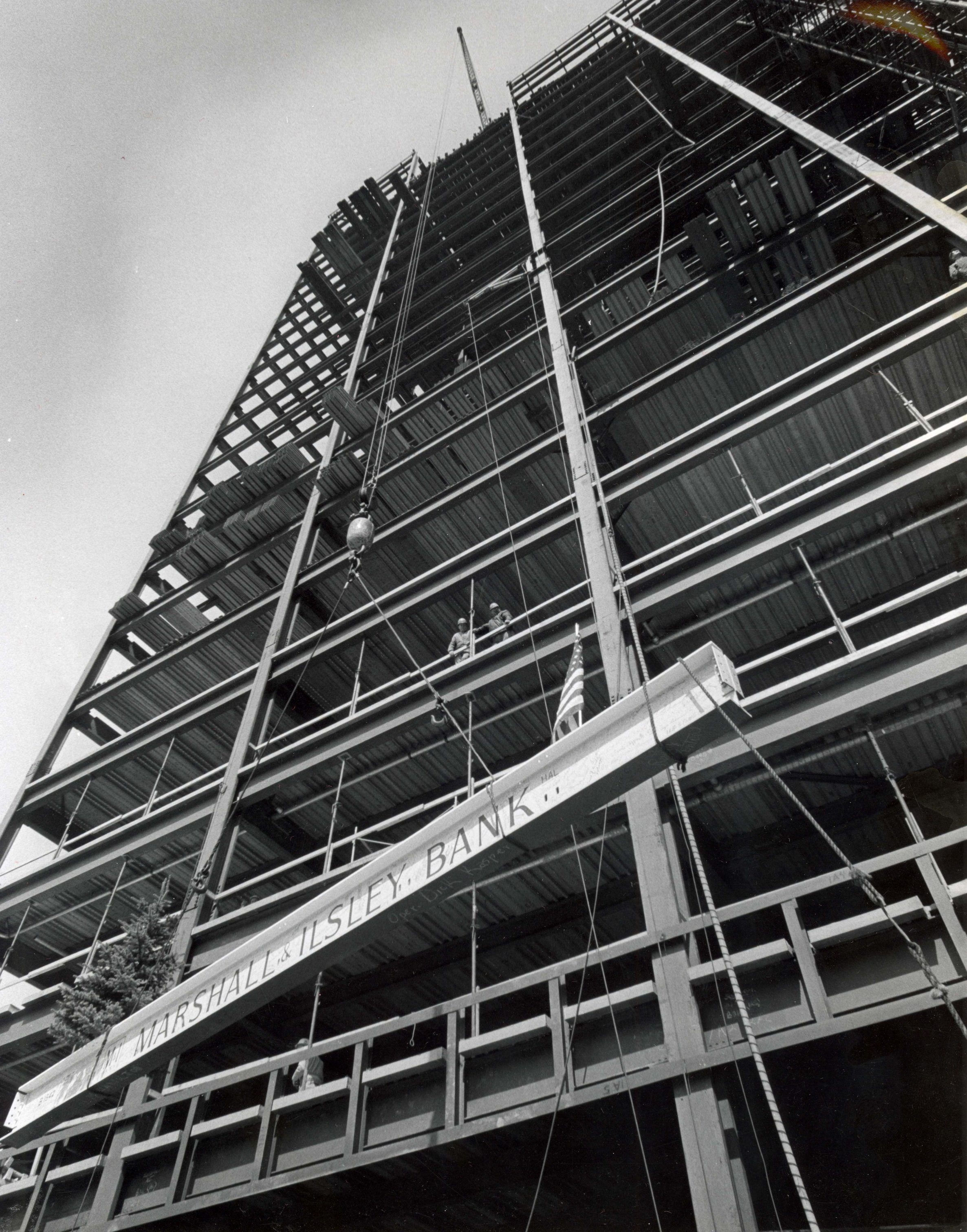Founded in 1847, Marshall & Ilsley Bank, or M&I, was Milwaukee’s oldest and largest bank before being acquired by Toronto-based BMO Harris Bank in 2011.[1] At the time of acquisition, M&I had $49.6 billion in assets, making it the largest Wisconsin-based bank.[2] From headquarters at 770 North Water Street, the bank employed 9,100 people, nearly half of them in Southeastern Wisconsin.[3] Although the M&I name no longer exists, nearly 200 BMO Harris branches operate in Wisconsin.[4] In 2015, BMO Harris was the second largest deposit holder in Wisconsin, with over twelve percent of the state’s market share.[5]
In 1847, Samuel Marshall, a Pennsylvania native and devout Quaker, opened an exchange brokerage on Milwaukee’s East Water Street.[6] Wisconsin law prohibited the chartering of banks prior to 1852, but Marshall’s office offered many traditional banking services.[7] After a brief partnership with William J. Bell, Marshall joined with Charles F. Ilsley.[8] An experienced banker, Ilsley had worked for Alexander Mitchell’s Wisconsin Marine & Fire Insurance Company since 1847.[9] Together, Marshall and Ilsley guided their bank through various economic crises of the nineteenth century, including the Civil War. Trusted by the incumbent governor, M&I was chosen to distribute state financial benefits to returning Civil War soldiers.[10] Although the bank’s leaders were both Yankee-Yorkers, M&I offered services for Milwaukee’s growing immigrant communities, including foreign correspondence banking and German-language deposit books.[11] By the time it sought a state charter in 1888, Marshall & Ilsley was the largest private bank in Wisconsin.[12]
During the twentieth century, M&I expanded geographically. The bank’s first branch opened in 1906 in Walker’s Point, allowing the bank to increase its services to Milwaukee’s immigrant communities.[13] In order to overcome later government prohibitions of branch banking, M&I created a bank holding company in 1958.[14] Through a series of mergers from the 1950s to the 1980s, M&I’s holdings made it the largest Wisconsin-based bank.[15] When interstate banking became possible, the bank expanded to Arizona in 1986.[16]
M&I was an early adopter of computerized banking. The bank began processing its checks by computer in 1961, and by 1963 it offered these services to its correspondent banks.[17] M&I brought together four local banks in the creation of the TYME cash machine network in the 1970s.[18] The bank took a leading role in the automation of banking by developing its own computer software, which it began selling to competing banks in the 1980s.[19] In 2007, M&I spun off this data services division, renamed Metavante, for $4.25 billion.[20]
Not long after spinning off Metavante, M&I was hit by the 2008 financial crisis. The bank, which had substantial mortgage holdings in hard-hit Arizona, recorded over $2 billion in losses in 2008.[21] M&I began looking for buyers in 2010, and in 2011, Wisconsin’s largest in-state bank was absorbed into the Bank of Montreal’s American business.[22] Together with Chicago’s Harris Bank, M&I Bank was renamed BMO Harris.[23] Familiar M&I Bank signs throughout Wisconsin were replaced by BMO Harris signage in October 2012, finalizing the loss of an iconic Milwaukee name.[24]
Footnotes [+]
- ^ Ellen D. Langill, Powered by Our Past: 150 Years of Marshall & Ilsley Bank, 1847-1997 ([Milwaukee]: M&I Corporation, 1997), 115; Cary Spivak, “M&I’s Dead End,” Milwaukee Journal Sentinel, July 9, 2011.
- ^ Paul Gores, “It’s Official: M&I Is Absorbed by Canada’s BMO,” Milwaukee Journal Sentinel, July 5, 2011.
- ^ Langill, Powered by Our Past, 125-126; Gores, “It’s Official.”
- ^ Paul Gores, “BMO’s Interest in Acquiring M&I Bank Started Years before Merger,” Milwaukee Journal Sentinel, August 1, 2015.
- ^ BMO Financial Group, “Q1 2016 Fact Sheet,” accessed May 16, 2016.
- ^ Richard H. Marshall, “Samuel Marshall, Pioneer Banker,” Wisconsin Magazine of History 32, no. 1 (1948): 26, 31.
- ^ Langill, Powered by Our Past, 11-12.
- ^ Marshall, “Samuel Marshall, Pioneer Banker,” 32-33.
- ^ Marshall, “Samuel Marshall, Pioneer Banker,” 32-33; Langill, Powered by Our Past, 21.
- ^ Marshall, “Samuel Marshall, Pioneer Banker,” 40.
- ^ Langill, Powered by Our Past, 19, 61, 68.
- ^ Langill, Powered by Our Past, 52.
- ^ Langill, Powered by Our Past, 61.
- ^ Langill, Powered by Our Past, 128.
- ^ Langill, Powered by Our Past, 128-131.
- ^ Langill, Powered by Our Past, 132.
- ^ Langill, Powered by Our Past, 134-135.
- ^ Langill, Powered by Our Past, 135.
- ^ Christopher K. Heaney, “Who Are These Guys Anyway?,” ABA Banking Journal 78, no. 5 (May 1986): 84-85.
- ^ Paul Gores, “M&I to Spin Off Metavante,” Milwaukee Journal Sentinel, April 4, 2007, http://www.jsonline.com/business/29252394.html, accessed May 2016.
- ^ Spivak, “M&I’s Dead End.”
- ^ Rich Kirchen, “Second M&I Suitor Bid Less than BMO,” Milwaukee Business Journal, February 2, 2011; Gores, “It’s Official.”
- ^ “New Name for M&I: BMO Harris Bank,” Milwaukee Business Journal, April 5, 2011.
- ^ Paul Gores, “BMO Harris Replacing M&I Bank Signs around State,” Milwaukee Journal Sentinel, October 4, 2012.
For Further Reading
Langill, Ellen D. Powered by Our Past: 150 Years of Marshall & Ilsley Bank, 1847-1997. [Milwaukee]: M&I Corporation, 1997.
Marshall, Richard H. “Samuel Marshall, Pioneer Banker.” Wisconsin Magazine of History 32, no. 1 (1948): 26-40. http://www.jstor.org/stable/4631982.

0 Comments
Please keep your community civil. All comments must follow the Encyclopedia of Milwaukee Community rules and terms of use, and will be moderated prior to posting. Encyclopedia of Milwaukee reserves the right to use the comments we receive, in whole or in part, and to use the commenter's name and location, in any medium. See also the Copyright, Privacy, and Terms & Conditions.
Have a suggestion for a new topic? Please use the Site Contact Form.